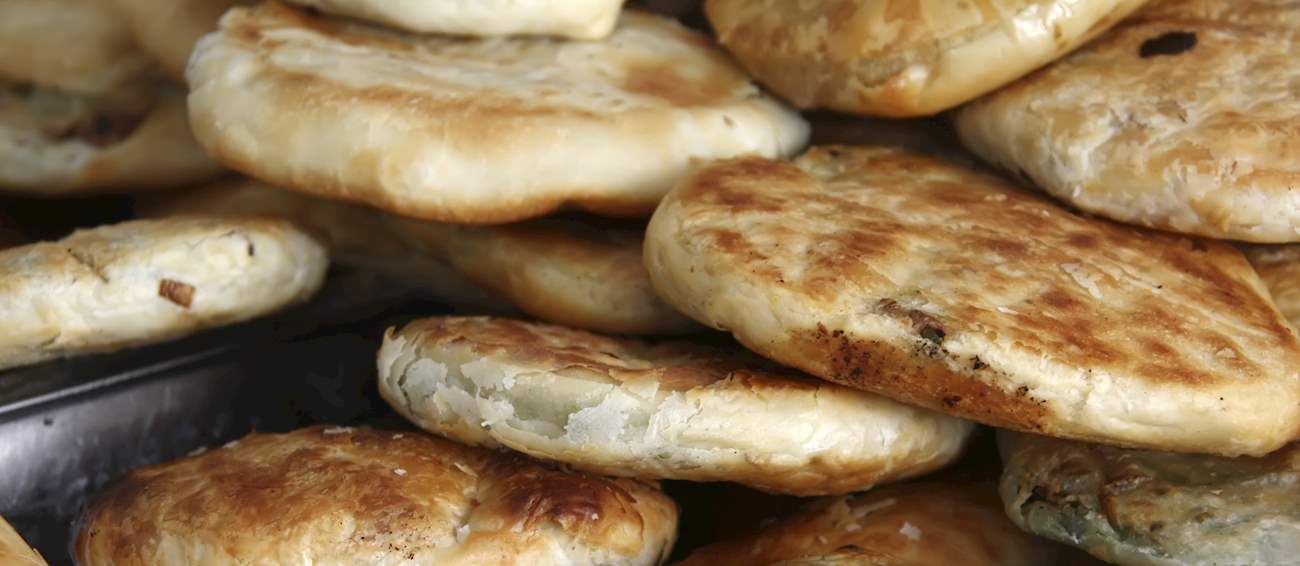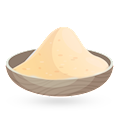MAIN INGREDIENTS
Scallion pancake is a Chinese unleavened flatbread made from wheat flour which is folded with oil and finely minced scallions. Bell peppers, fennel, and sesame seeds are some of the ingredients that are also often included in this pancake. It is usually served piping hot, cut into pieces or wedges, and served with a soy-based sauce.
Although the origins of scallion pancake are still quite murky, most people believe that it originated in Shanghai, due to the fact that scallion pancakes are very similar to the Indian paratha flatbread. Because of its unique flavor and texture, scallion pancake is one of the most popular street food items in China and Taiwan.
MAIN INGREDIENTS
Known as a common snack food in Northern China, shaobing is a type of layered flatbread, typically topped with sesame seeds. It is made with multiple layers of dough brushed with sesame paste and resembles a flattened bread roll. Shaobing originated in the Shandong province, but today it can be found at numerous street stalls throughout the country.
In fact, depending on the region, shaobing can be enjoyed in many different ways. In southern China, it is a popular breakfast choice, served with soy milk or tea and often stuffed with sweet fillings such as red bean, black sesame, or jujube (red date) paste.
MAIN INGREDIENTS
Mantou are Chinese steamed buns that are usually prepared plain, without any filling on the inside. It is sometimes served as a side dish, although it is more commonly consumed as it is. Mantou has a round, flattened shape, and it is a staple food of the Northern part of China.
Traditionally, the buns are tasteless and they have no crust, while the crumb is somewhat dense. They are made from wheat flour and yeast, which is used as a leavening agent. For Chinese people, mantou is as important as bread is to the westerners.
According to a popular legend, the word mantou literally means barbarian's head.
VARIATIONS OF Mantou
MAIN INGREDIENTS
Pineapple buns are golden, crispy-crusted, sweet pastries originating from Hong Kong. Despite their name, they don't contain pineapple, but are named after the chequerboard pattern of the crust that visually resembles the skin of a pineapple. An important part of Hong Kong's cultural heritage, they are made with only four ingredients - flour, lard, sugar, and eggs.
Crispy and sugary on the exterior and soft on the inside, it is a favorite food of many locals due to its inexpensive price. The buns are usually eaten for breakfast or in the afternoon with tea. One popular variation known as boh loh yaau is commonly consumed with milk tea and served with butter inside the bun.
MOST ICONIC Pineapple bun
View moreThe Asian interpretation of classic Portuguese bread rolls is known under the name piggy bun. They are usually oval-shaped and can come in various sizes and lengths. Although they might differ in crispiness and sweetness, most types usually have a light brown crust and a white soft interior.
A staple in Hong Kong and Macau, this bread item has been developed under European influences and is the direct legacy of Portuguese colonization in the area. In Hong Kong, they are usually enjoyed as a filling breakfast, spread with butter or condensed milk, and in Macau, they are used as the base of the legendary pork chop bun.
Although some may think this Chinese delicacy is a fruit, it is actually a white pastry bun with a reddish tip, visually mimicking the shape of a peach. It can be stuffed with either red bean paste, lotus paste, or custard. Longevity peaches are commonly found at Chinese birthday parties and banquets due to the fact that peaches have been a sacred item for the Chinese people for a long time.
More specifically, the dish represents a celestial peach that ripens once every few thousand years, and the legend says that those who consume it will achieve immortality. It can also be found at most Chinese pastry shops, supermarkets, and food stalls, arranged into impressive displays.
MAIN INGREDIENTS
Cream bun belongs to a group of traditional Chinese buns hailing from Hong Kong. Like most other varieties of Chinese sweet buns, this one also consists of a soft and fluffy yeast dough that’s typically made with a combination of bread flour, yeast, eggs, condensed milk, unsalted butter, tangzhong (a mixture of bread flour and water), custard powder, milk powder, salt, and sugar.
This classic bun can be recognized by its elongated elliptical shape; the nice, golden surface resulting from the use of egg wash, and the characteristic split down the middle. After baking, the sweet buns are usually cut open, brushed with sugar glaze, covered with shredded coconut, and filled with cream.
MAIN INGREDIENTS
Mandarin roll is a steamed bun with Chinese origins, consisting of wheat flour, sugar, water, vegetable oil, yeast, and salt. It is such an important part of Chinese cuisine that it is likened to white bread in western cuisine. Steamed Mandarin rolls are sometimes accompanied by sweetened condensed milk, while in the southern parts of the country the rolls are often sweet and can be eaten on their own.
Sometimes, the rolls are salted and filled with finely chopped spring onions on the interior. What makes these rolls unique is their unusual shape, reminiscent of flower blossoms, which is the reason for their alternative name - flower rolls.
MAIN INGREDIENTS
Cocktail bun is a simple sweet bun originating from Hong Kong and dating back to the 1950s. It was created from unsold, but edible buns that were ground with coconut and sugar and used as a filling for the new buns called cocktail buns. The name refers to a mix of ingredients that were similar to an exotic mixture of liquors.
Nowadays, the filling is usually enriched with butter or margarine. These buns can be found in most local bakeries, and they're usually finished with egg wash and a sprinkle of sesame seeds on top before baking.
MAIN INGREDIENTS
Amdo balep is a traditional Tibetan-Chinese flatbread and a type of balep originating from the Amdo region in the northeastern Tibet. The flatbread is usually made with a combination of flour, oil, sugar, yeast, water, and yogurt (optionally). The dough is kneaded until smooth, and it’s then flattened in a circular baking dish.
Once it doubles in size, the flatbread is baked in the oven and it’s turned so that both sides are evenly baked. Amdo balep is typically eaten warm. On special occasions with many people, locals often make a huge amdo balep so that everyone can get a piece.
TasteAtlas food rankings are based on the ratings of the TasteAtlas audience, with a series of mechanisms that recognize real users and that ignore bot, nationalist or local patriotic ratings, and give additional value to the ratings of users that the system recognizes as knowledgeable. TasteAtlas Rankings should not be seen as the final global conclusion about food. Their purpose is to promote excellent local foods, instill pride in traditional dishes, and arouse curiosity about dishes you haven’t tried.









